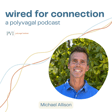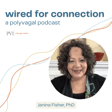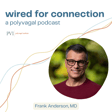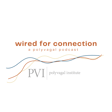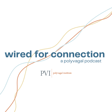
Stimulating the Vagus Nerve Naturally with Dr. Arielle Schwartz
In this episode of “Wired for Connection,” host Travis welcomes Dr. Arielle Schwartz, a clinical psychologist and expert in somatic psychology, to talk about the natural ways to stimulate the vagus nerve for physical, mental, and emotional health. Dr. Schwartz shares her professional journey—beginning with her personal experience with yoga and anxiety—and how this path led to her deep dive into polyvagal theory and natural mind-body therapies for trauma recovery. Together, they discuss accessible, practical vagus nerve stimulation techniques, the importance of self-compassion in healing, and how therapies like yoga, touch, and movement are essential for regulating the nervous system.
Natural Vagus Nerve Stimulation Is Accessible to Everyone:
Dr. Schwartz emphasizes that while there are technological devices for stimulating the vagus nerve, the most accessible—and often equally effective—methods involve practices like breathwork, yoga, self-massage, and gentle touch. These natural tools are free, always available to us, and can play a pivotal role in trauma recovery.
Healing Is Not About ‘Just Calming Down’:
Stimulating the vagus nerve isn’t only about down-regulating or calming the nervous system. It’s about increasing awareness of your nervous system state, meeting yourself with compassion, and developing the flexibility to shift between different states—energizing when needed, calming when needed, and, most importantly, beginning to feel safe in all of them.
Trauma Recovery Requires Patience and Personalization:
Dr. Schwartz encourages meeting yourself or your clients where they are—especially for those who feel disconnected from their bodies due to trauma. Gentle, titrated approaches such as self-applied touch around the face, simple movement, and sensory grounding can help rebuild a positive mind-body relationship. Progress might be slow, and that’s okay; the key is consistency and self-compassion.
If you’re interested in learning more, enroll in "Vagus Nerve Stimulation: Natural Neural Exercises to Enhance Emotional & Physical Health" at the Polyvagal Institute. Live classes start online September 9: www.learning.polyvagal.org/courses/Vagus-Nerve-Stimulation-Natural-Neural-Exercises-to-Enhance-Emotional&Physical-Health
CONNECT WITH Polyvagal Institute:
WEB: www.polyvagalinstitute.org
Instagram: @polyvagalinstitute
LinkedIn: polyvagal-institute
Email: community@polyvagal.org
CONNECT WITH Travis Goodman:
Web: TravisGoodmanlmft.com
Instagram: Travis.Goodman.LMFT
YouTube: youtube.com/travisgoodman
